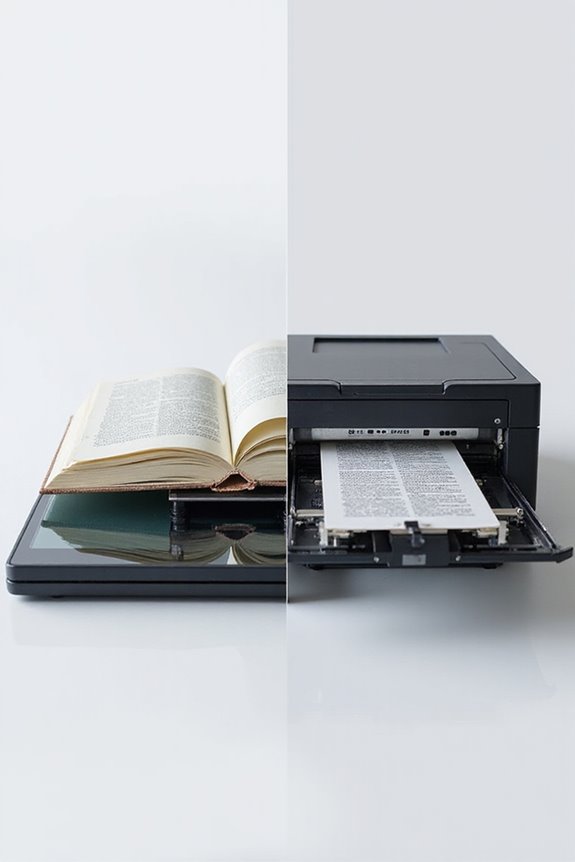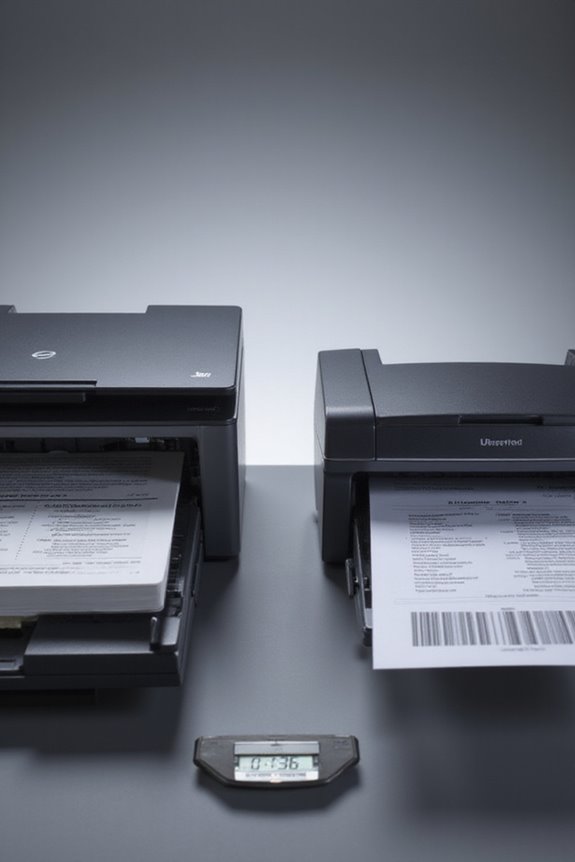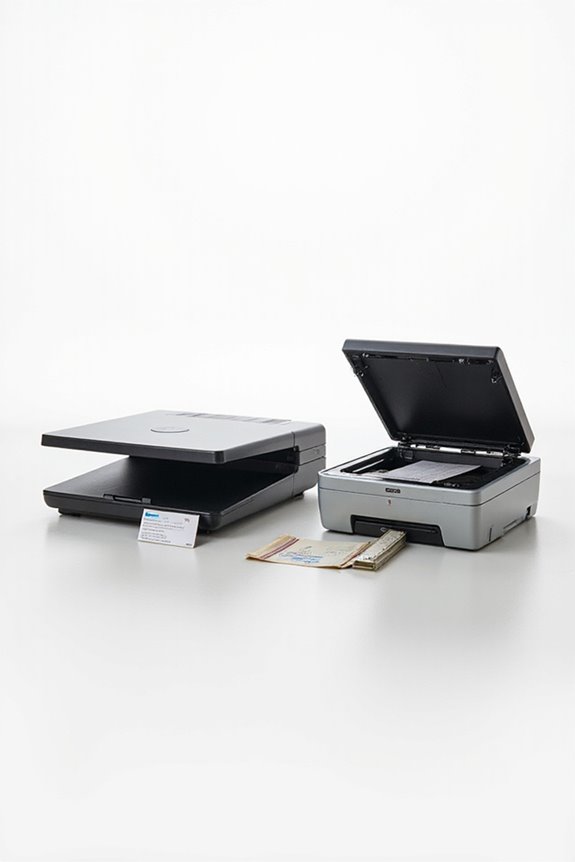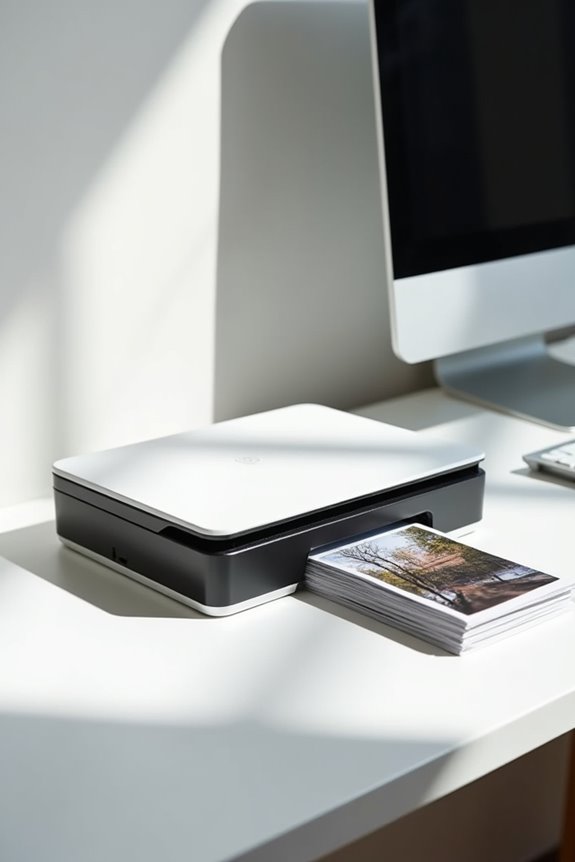When we compare flatbed and sheet-fed scanners, we find key differences tailored to specific needs. Flatbed scanners offer high resolution, making them perfect for delicate materials, while sheet-fed scanners excel in speed, reaching over 100 pages per minute, ideal for high-volume tasks. Flatbeds handle various document types with precision, whereas sheet-fed versions are compact and efficient for standard pages. Understanding these distinctions helps us choose the right scanner for our projects. Let’s explore more about their features and benefits.
Key Takeaways
- Flatbed scanners use a glass platen for precise image capturing, while sheet-fed scanners utilize rollers to feed documents automatically.
- Flatbed scanners excel at handling fragile or oversized documents, whereas sheet-fed scanners are limited to standard-sized and less delicate materials.
- Sheet-fed scanners operate faster, averaging 15 to over 100 pages per minute, compared to flatbeds scanning between 2 to 60 pages per minute.
- Flatbed scanners typically offer higher resolution, often exceeding 2400 dpi, ensuring better image quality and detail than sheet-fed scanners.
- Flatbed scanners are larger and pricier, suitable for specialized projects, while sheet-fed scanners are compact, affordable, and portable for standard document handling.
Scanning Technology and Mechanism
When we look at scanning technology and mechanism, two main types stand out: flatbed and sheet-fed scanners. Flatbed scanners have a transparent glass platen illuminated by an internal light source, allowing for precise image capturing of stationary objects. Their scanning mechanisms prevent distortion by keeping the document still. On the other hand, sheet-fed scanners use a roller mechanism to feed documents through one page at a time. While this speeds up the scanning process, it can lead to skewing if not aligned correctly. Flatbed scanners deliver higher resolutions than sheet-fed models, making them ideal for delicate or varied materials. For those needing quick, high-volume scans, sheet-fed might be the better fit, despite occasional image quality trade-offs. Additionally, scanning speed is a crucial factor when deciding between the two types, as sheet-fed scanners typically offer faster performance for bulk documents.
Document Handling Capabilities

Document handling capabilities play an essential role in determining how effectively a scanner meets our needs. Flatbed scanners excel at handling various document types, including fragile or bound materials, which can’t be fed through rollers. Their flexible design accommodates document thickness, allowing us to scan oversized items like blueprints easily. In contrast, sheet-fed scanners utilize automatic feeding, efficiently processing stacks of standard-sized pages. However, they can’t manage thicker or delicate documents, posing potential risks during scanning. While flatbeds offer high precision and capture the entire document area at once, sheet-fed models prioritize speed, making them suitable for bulk tasks. Understanding these distinctions is vital in selecting the right scanner for our specific document handling requirements. Additionally, optical character recognition technology enhances the functionality of many scanners, enabling better text management and retrieval.
Scanning Speed and Efficiency

Scanning speed and efficiency are essential factors that guide our choice between flatbed and sheet-fed scanners. Generally, flatbed scanners scan between 2 to 60 pages per minute, depending on the model, while sheet-fed scanners outperform them, averaging 15 to over 100 ppm. In efficiency comparison, sheet-fed scanners shine, as they’re designed for high-volume tasks with automatic sheet feeding capabilities. With duplex models reaching up to 150 ppm, they save valuable time. In contrast, flatbeds require manual placement of pages, making them less efficient for bulk scanning. For projects needing quick results, sheet-fed scanners provide continuous multi-page scanning, proving ideal for busy offices. Furthermore, duplex scanning captures both sides in a single pass, enhancing workflow efficiency. Ultimately, understanding these differences can enhance our workflow and productivity.
Image Quality and Precision

Image quality and precision are essential elements in choosing the right scanner for our needs. When we consider resolution comparison, flatbed scanners typically offer higher maximum resolutions, often exceeding 2400 dpi. This allows us to capture fine details and guarantees color fidelity in photos and artwork. They preserve edge details better since documents remain flat during scanning. In contrast, sheet-fed scanners have lower resolution ceilings and can introduce image skewing, potentially losing important details. Furthermore, flatbeds provide consistent results due to their stationary design, enhancing overall clarity and sharpness. While sheet-fed models improve in resolution, they still can’t match the detail flatbeds capture, making flatbeds our best choice for high-quality, precise digitization. Additionally, flatbed scanners like the Epson Perfection V600 are known for their high optical resolution and advanced features that enhance image quality.
Size, Cost, and Portability

When choosing a scanner, size, cost, and portability are essential factors to take into account. Flatbed scanners typically have larger dimensions, accommodating oversized documents like posters or books. Conversely, sheet-fed scanners focus on standard-sized documents and are generally more affordable. In a price comparison, flatbed models can be pricier, especially high-end versions suited for specialized projects. For those on a budget, sheet-fed scanners provide excellent options for users handling standard paper stacks. Portability is another significant aspect; sheet-fed scanners are compact and lightweight, making them easy to transport. Flatbed scanners tend to be bulky, limiting mobility. For someone needing flexibility, consider the trade-offs between scanner dimensions, cost, and usability in different environments. Additionally, many document scanners are designed for fast scanning speeds, enhancing efficiency in classroom settings.
Use Cases and Applications
In today’s digital world, understanding the use cases and applications of flatbed and sheet-fed scanners helps us choose the right tool for our needs. In office environments, sheet-fed scanners shine by efficiently processing high-volume document digitization, thanks to their automatic document feeders. They’re ideal for standardized forms like invoices and purchase orders. Conversely, flatbed scanners excel with fragile or specialized materials, safely handling delicate items like old photographs or bound documents. For oversized documents, flatbeds provide the necessary precision. While sheet-fed models offer quick throughput, flatbeds guarantee superior image quality, making them essential for specific tasks. Additionally, investing in a speedy scanner can significantly enhance overall productivity for businesses that require fast document management. Knowing these applications allows us to select the perfect scanner for our unique projects and requirements.
Advantages of Flatbed Scanners
Flatbed scanners offer a range of advantages that make them an excellent choice for various scanning needs. One key benefit is their user-friendly operation, allowing us to place items directly on the glass surface without complex loading. They can handle diverse applications, from photographs to 3D objects, accommodating both thick and fragile materials without damage. The high-resolution scans produced are ideal for capturing fine details, ensuring accuracy across document edges that might be missed with other scanners. Additionally, stationary scanning minimizes the risk of paper jams and distortions. With fewer moving parts, flatbed scanners are often more durable and require less maintenance, making them a practical solution for both home and professional use.
Advantages of Sheet-Fed Scanners
While flatbed scanners excel in versatility and detailed image capture, sheet-fed scanners stand out for their speed and efficiency, especially in high-volume settings. These devices can handle hundreds or even thousands of pages daily, thanks to their automatic document feeding (ADF) capability, which enhances user experience by allowing unattended batch scanning. Their compact design saves desk space, making them ideal for tight work environments. Additionally, sheet-fed scanners are designed for durability, ensuring reliable performance over long periods, which greatly reduces maintenance considerations. With features like duplex scanning, they efficiently process multi-page documents, boosting productivity in demanding offices. Overall, sheet-fed scanners provide a practical solution for fast, dependable document digitization without the clutter.
Choosing the Right Scanner for Your Needs
How do we decide which scanner best fits our needs? First, we should consider the types of documents we’ll be scanning. If we need to handle fragile items or odd sizes, a flatbed scanner’s features are ideal. Flatbeds provide higher quality and accuracy, especially for detailed scans, thanks to their stationary design. On the other hand, if we’re looking to scan large volumes quickly, a sheet-fed scanner might be our go-to choice, given its ability to handle multiple flat documents effortlessly. Ultimately, our decision should align with our specific user preferences—whether we prioritize speed or quality, or perhaps versatility over volume. Understanding these scanner features helps us make an informed choice tailored to our requirements.
Frequently Asked Questions
Can I Connect Flatbed or Sheet-Fed Scanners to My Computer Easily?
Absolutely, we can easily connect either type of scanner to our computer. With various connection methods like USB and Wi-Fi, both offer great scanner compatibility, ensuring we can integrate them into our workflows effortlessly.
What Maintenance Do Flatbed and Sheet-Fed Scanners Require?
We often overlook scanner care, thinking it’s hassle-free. However, regular maintenance tips like cleaning, inspecting components, and updating software truly keep our flatbed and sheet-fed scanners running smoothly and producing quality scans.
Do Flatbed and Sheet-Fed Scanners Support Wireless Connectivity?
Yes, both flatbed and sheet-fed scanners increasingly support wireless capabilities. These scanner features allow us to scan and share documents conveniently, enhancing our efficiency in various environments, whether for home or office use.
Are There Specific Brands Known for Quality in These Scanners?
When it comes to scanner reliability, we should consider brand comparisons. Epson and Canon lead in flatbed quality, while Fujitsu excels in sheet-fed performance. Finding the right fit can make all the difference in our scanning needs.
How Do I Resolve Paper Jams in Sheet-Fed Scanners?
To resolve paper jams, we recommend following these paper jam solutions: inspect documents, align sheets, and clean rollers. Implementing these scanning tips helps minimize future jams, ensuring smoother and more efficient scanning processes.





